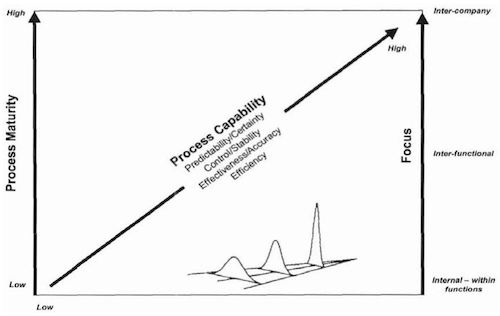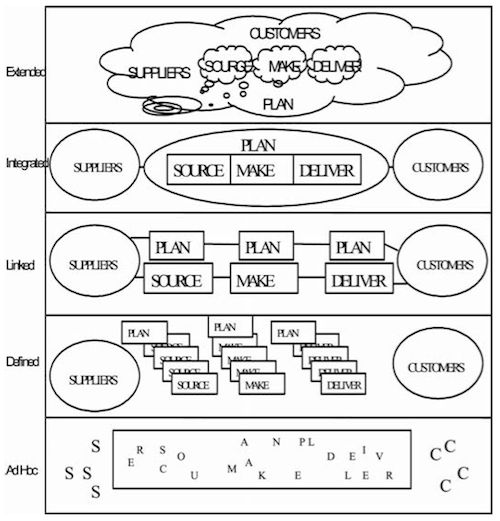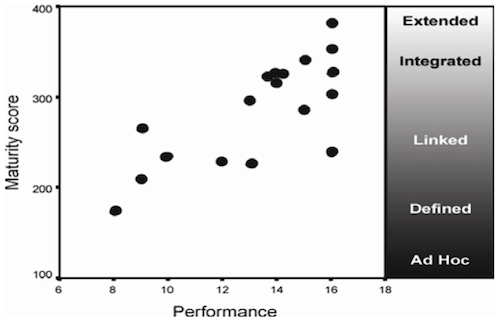Effects of Process Maturity and Uncertainty on SC Performance
Process orientation may or may not be a very hip topic right now. Nevertheless effective processes are a foundation for company performance. Lockamy, Childerhouse, Disney, Towill and McCormack (2008), analyze and explain the impact of process maturity and uncertainty on supply chain performance, the full paper can be obtained here free of charge.
In close collaboration with several businesses they conducted an empirical study on this topic, which I present in the following.
Business Process Orientation and Quickscan
Business process orientation can be described using the dimensions process management, process jobs and process view.
- Process management & measurement means that the company is using metrics on aspects of the process such as output quality, cycle time, process cost and variability, in contrast to traditional accounting measures.
- Process jobs focus on processes as opposed to functions, and are cross-functional in responsibility.
- Finally, process view is the cross-functional, horizontal picture of a business involving elements of structure, focus, measurement, ownership and customers.

The authors used the Quick Scan methodology with over 20 different supply chains. It consists of the following four methods: questionnaire analysis, process mapping, semi-structured interviews, modelling from numerical data.
Each quick scan took about two weeks at the site of the client and resulted in: a current status of the organization and the supply chain, evaluation of the maturity of its practices and processes and its ability to meet current and future customer needs, furthermore details on the management of uncertainty and interfaces beteween these areas.
Supply Chain Maturity and Uncertainty
Supply chain maturity is described here using five cumulative levels:
- Ad Hoc, marks an unstructured supply chain with badly defined processes. Typical are no process measures and few “process jobs”.
- Defined, stands for a level where processes and the supply chain has been defined. Process performance is measured sometimes.
- Linked, describes a level where supply chain management jobs have been established and performance measures are conjointly evaluated with clients and vendors.
- Integrated, traditional functions beginn to disappear, supply chain measures and management is embedded into the organization. This leads to reduced SC cost.
- Extended, collaboration is routine, competition is based on a multi-firm supply chain.

Supply chain uncertainty is defined similar to Christopher and Peck (2004) and devided into process, control, supply, demand uncertainty. Based on other empirical study it can be stated that:
Supply chain uncertainty significantly contributes to poor customer service levels, excess inventory, long lead times, increased quality inspections, and bureaucratic decision-making processes.
Results
After collecting all data during the quick scan on the process maturity and experienced supply chain uncertainty levels the author drew the following conclusions:
- Reductions in supply chain uncertainty can be achieved by increasing the maturity levels of processes employed within the supply chains
- By increasing supply chain maturity levels and by correspondingly reducing uncertainty, firms can improve overall supply chain performance
- Levels of maturity in the area of process structure and jobs can significantly reduce the level of control uncertainty within supply chains
- Reductions in demand and control uncertainty can be achieved by increasing the maturity levels of process measures utilised within supply chains

Conclusion
One would think that better processes lead to better supply chain performance. But it is hard to objectively measure the maturity of a specific process. How do you grade them. For example maybe a process is documented, but to which level of detail and how are current is it? There are processes that work perfectly without having a process chart available which documents the exact interfaces.
So evaluating processes is always an extremely subjective task. I trust the reputation of the participating author that they used all due diligence necessary. Nevertheless it would have been great to see more details on how the evaluation has been conducted.
Lockamy, A., Childerhouse, P., Disney, S., Towill, D., & McCormack, K. (2008). The impact of process maturity and uncertainty on supply chain performance: an empirical study International Journal of Manufacturing Technology and Management, 15 (1) DOI: 10.1504/IJMTM.2008.018237
Christopher, M., & Peck, H. (2004). Building the Resilient Supply Chain The International Journal of Logistics Management, 15 (2), 1-14 DOI: 10.1108/09574090410700275








Add new comment